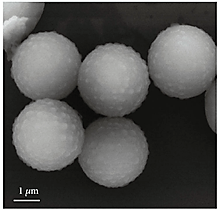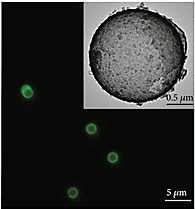Thanks to the joint work of theoretical and experimental researchers, scientists have developed a model to understand the mechanism by which the microrobots are propelled, as well as a possible solution to avoid mobility loss when salts are present in the medium, as occurs in physiological media.

Microrobots are spherical or cylindrical biocompatible and biodegradable structures developed with nanobioengineering techniques. One of its most important characteristics is that they are capable of self-propelling within liquids, that is, of moving by themselves without external manipulation, as if they were microsubmarines. The research group ” Smart nano-bio-devices” of the ICREA research professor Dr. Samuel Sánchez from the Institute for Bioengineering of Catalonia (IBEC) in Barcelona is a pioneer in the study and development of microrobots powered by enzymes, catalytic machines on a nanoscopic scale.
Fig.1. Scanning electron microscopy image of the microrobots showing their rough surface. Source: Ionic Species Affect the Self-Propulsion of Urease-Powered Micromotors. Research, 2020.

Traditionally, the movement of these microrobots has been studied in water, but now, researchers have just taken a further step towards their real application in physiological environments, since they present a more complex composition including salts and ions. Specifically, researchers have discovered that the concentration of salts in the liquid is crucial for the mobility of microrobots. Sánchez, his team and collaborators publish this in two articles, in the Physical Review Letters and Research journals, and conclude that the movement of microrobots occurs as a function of the amount of salts present in the liquid in which they are found: the greater concentration of salts, the less movement. They also suggest a solution to avoid microrobots´ loss of mobility.
Fig.2. Fluorescence microscopy image showing urease (marked in green) adhered to the surface of the microrobots. Inset: transmission electron microscopy image of a microrobot. Source: Ionic Species Affect the Self-Propulsion of Urease-Powered Micromotors. Research, 2020.
A new model to explain mobility
The microrobots developed by IBEC researchers are active particles in which an enzymatic reaction occurs: they are coated with urease, the enzyme that breaks downs urea and transforms it into carbon dioxide and ammonia. It is the breakdown of urea that makes the microrobot move. Classically, the study of the movement by propulsion of this type of particles has given importance only to the generation of chemical products (with or without charge) in an asymmetric way around the microrobot, that is, when amounts of product released are not the same throughout the surface. In other words, the approach until now was that the movement of microrobots depended only on the generation of chemicals, charged or not. However, this model could not explain the observations of IBEC researchers, who saw that in the presence of salts, the movement was reduced. For this reason, in a first study published in the journal Physical Review Letters, with the collaboration of Dr. Marino Arroyo, Professor at the Polytechnic University of Catalonia (UPC) and Associate Researcher at IBEC, the researchers have applied a general movement model for chemically active particles that are propelled releasing charged particles, called ions, to study the movement of these microrobots.
The detailed theoretical study of this model indicated that the speed of movement of the microrobots depends on the amount of salts in the medium, being lower at high concentrations. Contrary to classical theories, movement does depend on the release of products that have a charge, so that when there are salts in the medium this charge interacts with them and the appropriate chemical conditions for the movement do not take place. That is why in the presence of salts there is less movement. These theoretical findings have been verified in a first experimental approach, comparing the movement of the microrobots in pure water and in water with different concentrations of the main component of kitchen salt, sodium chloride (NaCl).
Theory and experiments explain that microrobots move by release of ions, so their presence in the medium, in the form of salts, affects their movement.
Marco De Corato, first co-author of the work published in “PhysRevLett”
Experiments and a new coating to avoid losing mobility
In a second study, with more experiments and published in the journal Research, the scientists and nanoengineers studied the movement of microrobots under physiological conditions and in media with varying concentrations of salts, and with different pHs (a measure of the acidity of the medium). To eliminate a possible contact effect of the microrobots with the bottom surface of the container altering the movement, they confirm that these move in 3D using digital holographic microscopy.
Since salts are one of the main components of physiological media, it is essential to minimize their negative effect, so that microrobots can be used in biomedical applications. To achieve that goal, the researchers modified the surface of the microrobots with a coating of a polymer called polyethylene glycol, and observed that the speed increased significantly at intermediate concentrations of salts without influencing enzyme activity.
Understanding the physicochemical mechanism by which microrobots are propelled is essential for their correct use in a controlled manner in future biomedical or technological applications.
Xavier Arqué, first author of the work published in “Research”
Reference articles:
Marco De Corato, Xavier Arqué, Tania Patiño, Marino Arroyo, Samuel Sánchez and Ignacio Pagonabarraga (2020).Self-Propulsion of Active Colloids via Ion Release: Theory and Experiments. Physical Review Letters, 124(10), 108001.
Xavier Arqué, Xavier Andrés, Rafael Mestre, Bernard Ciraulo, Jaime Ortega Arroyo, Romain Quidant, Tania Patiño, and Samuel Sánchez (2020).Ionic Species Affect the Self-Propulsion of Urease-Powered Micromotors. Research, Volume 2020, Article ID 2424972.
About IBEC
The Institute for Bioengineering of Catalonia (IBEC) is a CERCA center, twice recognized as a Severo Ochoa Center of Excellence, and a member of the Barcelona Institute of Science and Technology (BIST). IBEC conducts multidisciplinary research of excellence on the frontier between engineering and life sciences to generate knowledge, integrating fields such as nanomedicine, biophysics, biotechnology, tissue engineering and information technology applications in the field of Health. IBEC was created in 2005 by the Generalitat of Catalonia, the University of Barcelona (UB) and the Polytechnic University of Catalonia (UPC).





